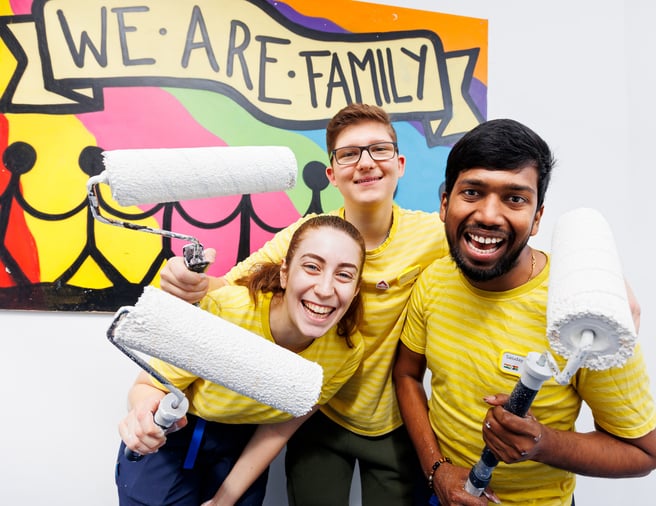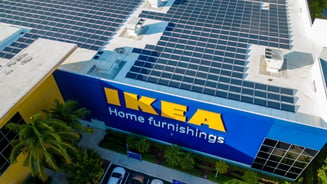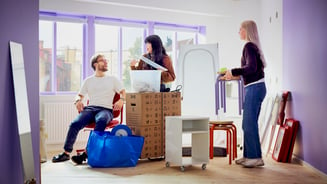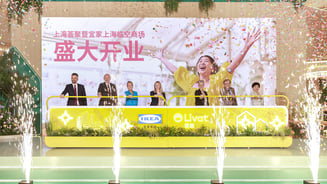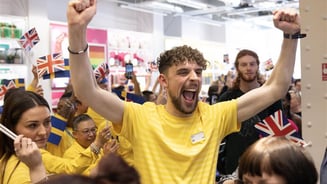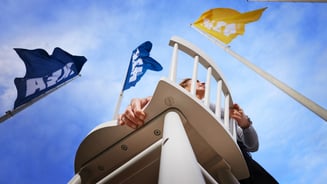In this conversation, Ethel Bergman Carter, Human Rights and Social Impact Specialist at Ingka Group, shares how her team works across global markets to embed equality, resilience, and inclusion into communities. From trauma-informed design in homeless shelters to refugee employment and social entrepreneurship, we explore how business can drive systemic change. It’s a frank, hopeful, and deeply human conversation about purpose, participation, and how good design can change lives.
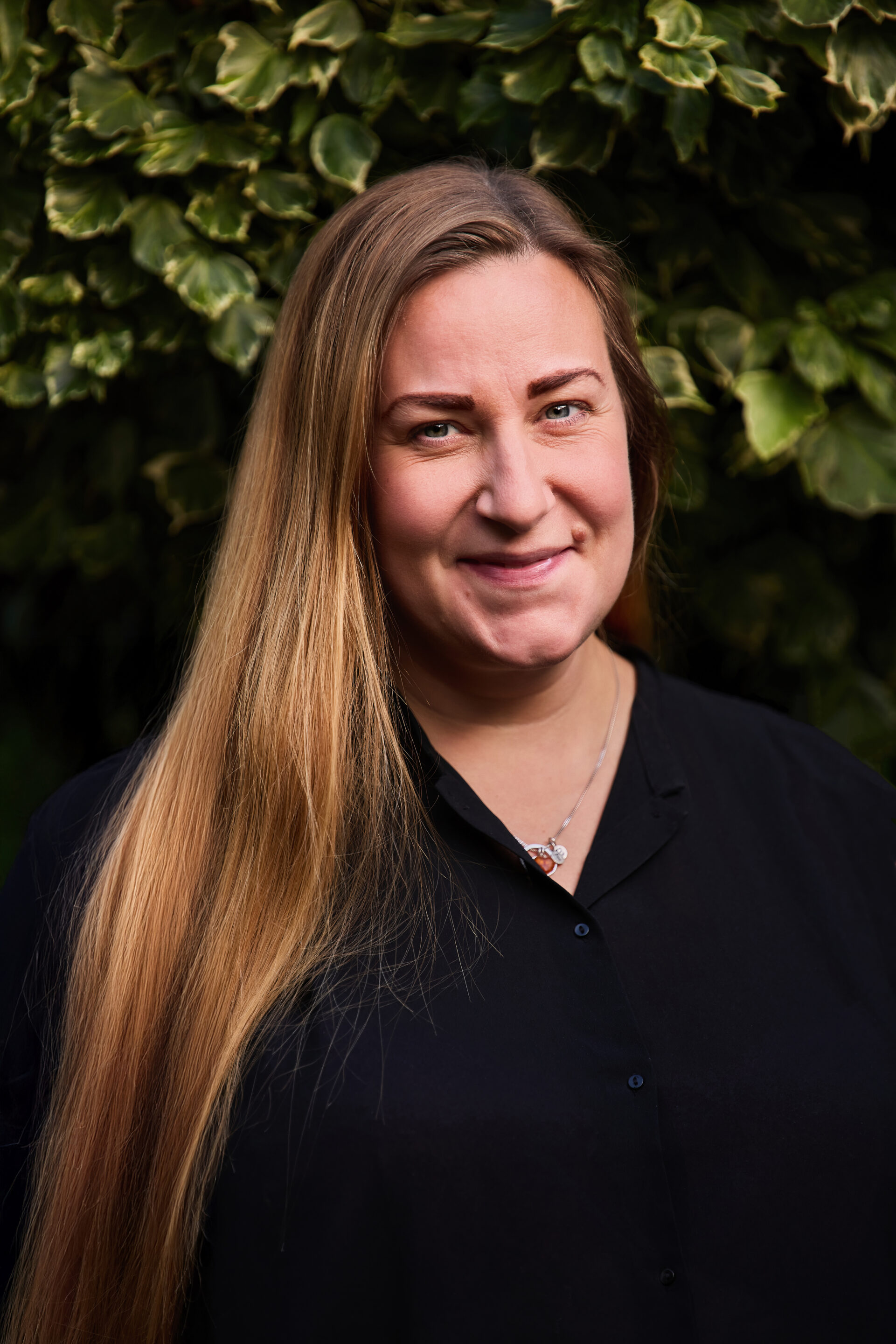
Ethel Bergman Carter, Human Rights & Social Impact Specialist at Ingka Group, IKEA.
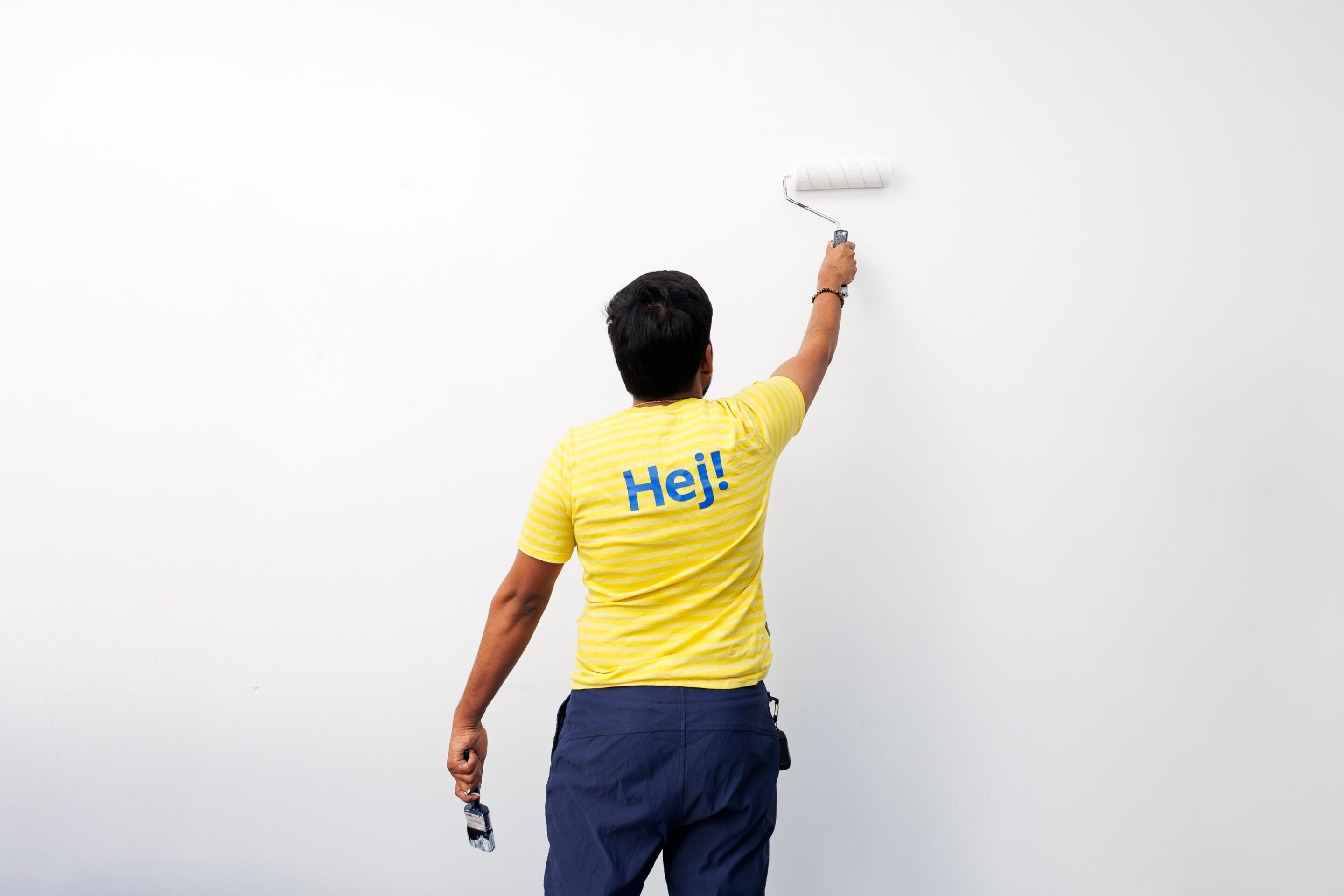
IKEA transforms Hackney Community Centre, UK (also captured in the header photo).
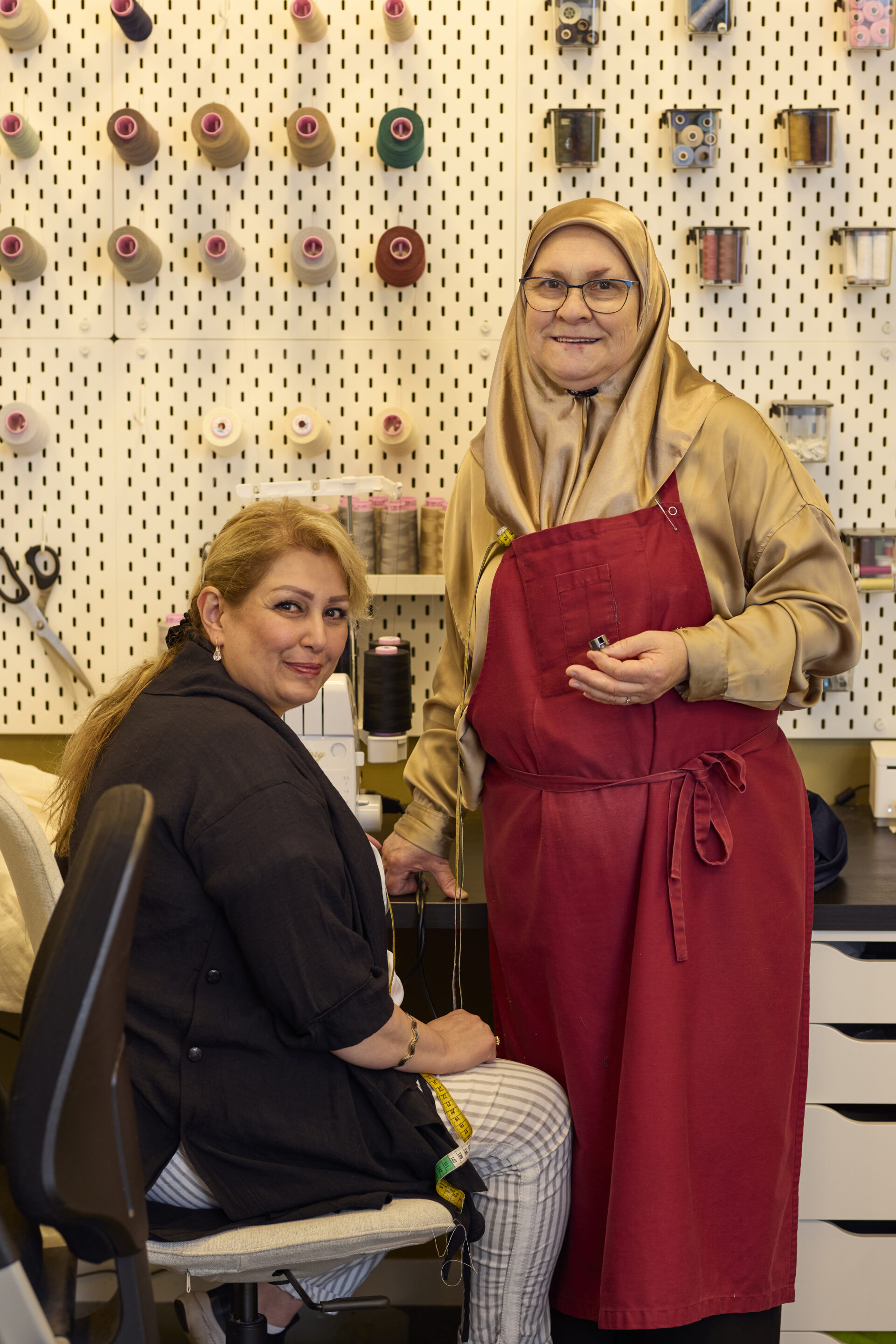
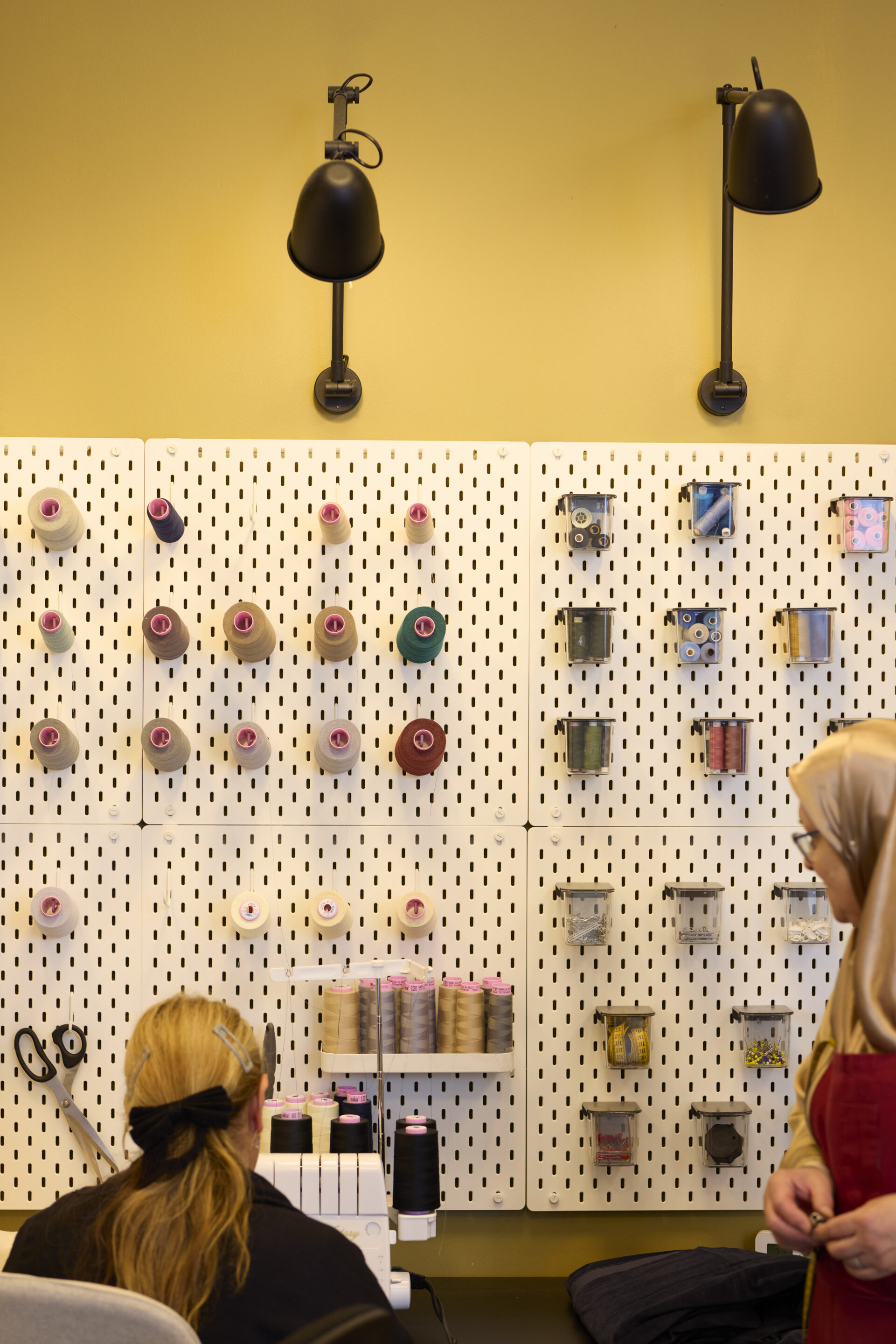
Yalla Trappan at IKEA store, Malmö, Sweden.
Full transcript available below:
Hello, I’m Kat and I’m joined here by Ethel who is our… Let’s see if I get it right – Human Rights and Social Impact Specialist. Thank you for joining me.
Thank you for having me.
So first off, I’m just going to ask a really random question to you because we were talking about it earlier. So I call it furniture pads… You call it floor protectors. And that is?
It’s what you put on the bottom of all your furniture with legs, makes the furniture more stable. It makes it feel higher quality. Protects your floors, of course.
And it is the best product that we have at IKEA. Why?
Just amazing. I mean, it’s multi-purpose and also cheap for the many people, and just makes your furniture and floors last longer. So, I don’t see why it wouldn’t be anyone’s favorite product, actually.
So back to something more important then, your role. Tell me, how did you end up here?
Oh, it’s a long story, but I’ll try to keep it quite short.
No, go for it.
I started in IKEA in 2015. So that’s fiscal year 16 for us, in a management trainee program. So I had the great honor of starting in Älmhult, the core of our heart of where IKEA’s, and I worked with range dimensioning. So figuring out what products we put on which market, because we have a limited amount of products that we can have in each store.
But of course, I wanted to return to what I’m most passionate about, which is sustainability. So I applied for a job here in Malmö. I started working with, water stewardship. I used to live in India working on water and sanitation issues. So I started there and then I came back a year later and worked for the same organization again, working on, figuring out why people weren’t using their eco sanitary toilets that were around rural areas in India.
Also a long story, but super interesting. So water stewardship at IKEA back then. It was a collaboration with WWF, for us to figure out how are we going to be a water positive company. So how do we protect water resources? How do we take just as much as we need, and how do we return what we have used? So it’s maybe even cleaner than it was when we started using it. It can be anything from technologies like, toilets to flush with rainwater can also be how we, replenish watersheds around us. It can be all sorts of things. It’s really understanding that there are different issues with water. It can be too much, too little or too polluted.
And this is work that’s now being done by one of my other fantastic colleagues, who’s also in the sustainability team here at Ingka. And I’ve moved on to different things. Like you said, now I work as a human rights and social impact specialist, focusing on the work we do in our local communities.
What does that mean? What do you do? So you go to work and you have a cup of coffee, and then what is the rest of your day or week look like?
Well, I get to do lots of exciting things. So a few years ago we started looking into this because we don’t want to do CSR, which would be just looking at the output of what we do, not the actual outcome. So an output would be, oh, how many, how much money did we donate. But an outcome would be how many people’s lives have we positively impacted. And that is the work I do because it’s in our strategy. It’s what we want to do. It’s how we want to leave a mark on society. It’s the things we do that are not required by us as a company. And it’s all those things that we feel that we should be doing, even though we’re not required to do them. So social impact is the things we do that are connected to human sustainability. So, we’re trying to positively impact people who are at risk of or experiencing homelessness and or just being outside of society, which can be different kinds of groups. It can be refugees. It can be women, who have been subjected to domestic violence. But we are also focusing on youth and children, for example. So we have, initiatives going on in all our markets.
So within IKEA retail, we had almost 2000 initiatives in fiscal year 24, which is amazing.
And you said this is not something that we have to do. This is something that we want to do. Is that a tough sell to the wider business?
It can be. Definitely because we are not driven by profit in itself. And the things we do when we talk about social impact, we know it’s a good business to be a good business. Of course, that’s a side effect of the things we do, but that’s not the aim of it in itself. The aim is to live up to our vision, which is to create a better everyday life for the many people, and the many people doesn’t necessarily have to be all of our customers. It can be other people as well. Maybe those who can’t afford to shop at IKEA, even, we forget about them sometimes. And many of the things we do, for example, we furnish, shelters for homeless people that’s giving them access to a safe place to call home, even if it’s just for the moment. Because it is a human right as well, access to adequate housing. So it’s connected to the other part of my title, working with human rights. So we have four movements. I don’t know, would you like me to tell you more about them?
Yes, and I want to dive in more into what you were just telling me.
So, Shelters?
Yes.
I think you mentioned a term that I was not familiar with called Trauma Informed Design. Tell me about that.
Absolutely. So the first movement, it’s a great link to that. Our first movement is ‘access.’ Well, increasing access to better homes. And this actually came from work we did during the Covid pandemic, where we worked with A Place Called Home, emergency community support for those experiencing different problematic situations because of Covid. And that we could say sparked the whole work with Ingka neighborhoods, the work we do in social impact. So, increasing access to better homes during Covid led to all of this, which is a great thing. Well, we were already working on it, but that really showed us that there’s a bigger purpose. There is an ask from our markets to to have a more, formalized way of doing this and also ways of measuring, but increasing access to better homes.
The first movement became the focus for one of our pilot markets. So one of the markets where we work together to develop this whole approach, and that was the United States. So what we did was we invited coworkers, we invited local organizations, even local authorities to meet with us for workshops. We call them ‘what co-creation’ and ’how co-creation.’ We talk about what is the actual root cause of homelessness, for example, what we see in society and then in the ‘how co-creation’ we go into how can we be a player in tackling this root cause and change the situation as we see it, because homelessness is just the tip of the iceberg. There’s so many things underlying that can cause this. We have statistics on this, and we’ve talked about this before, you and I… that 64%, I think, of Americans have experienced some sort of trauma in their life when they were children. And it can be domestic violence. It can be sexual abuse. It can be just not having a safe home. And those things can lead to both physical and mental problems later on in life. And we know for a fact that homelessness is one of those things that if you had a troublesome childhood, you can end up doing drugs, for example. And that can lead to homelessness or experiencing homelessness, I should say. So what we did, we discovered there are things we can do using our expertise with home furnishing. And we learned and, also invited experts.
So we started working with this concept of trauma informed design, which is not something we’ve invented. So it exists. It’s something that is before this, there are studies made on this. But we realized here’s an opportunity for us to become experts as well, because of all the wonderful products we have. So we built a small home. We put it in Towne Twin Village, which is a housing first community, which means, you don’t have to be clean, so to say, in the sense that you can still, use drugs, alcohol. But the point – the goal – is, of course, to get support.
Yeah I read somewhere that you ask the question ‘what happened to you?’ instead of ‘what’s wrong with you?’
Exactly. Yeah. So that is understanding the underlying trauma. Why? What happened? And we built this small unit, with the principles of trauma informed design.
What is trauma informed design?
Like, if you walk into a room, you will feel calm, you will feel it’s not cluttered. It’s very, neutral colors, but it’s also a multi-purpose kind of area, so that you can rearrange the furniture if you want to have guests, but you can move them or like, stow them away so they’re not always visible for you. So you don’t have to constantly have clutter around you. But it’s also about the colors and the way the furniture is arranged and how the windows are built. And of course, we also built this in a sustainable way using wood.
And the idea is further, I don’t think the solar panels are up yet, but the idea is to put solar panels on the roof as well. And we had a wonderful man move into this unit. And I think in a few months we’re doing a follow up with him evaluating and the idea is for this to be spread across the US and hopefully for us actually to start offering Trauma Informed Design as a business product. So something that businesses can also come to us for. And, if someone is building more units around the world, they can come to us as experts in trauma informed design, because it’s not just for people who have lived that kind of trauma. Everyone has some kind of trauma in their life. So it’s actually useful for everyone. It can be even a dental practice that we could help decorate. So we’ve discovered a business opportunity through this as well, actually.
And what else? Like, all the work that you do, it must be, at times, quite heavy?
It is. But the wonderful thing is that we know that we are creating positive impact. Of course, the work with human rights is more, limiting or mitigating negative impact. Social impact is really creating the positive effects, the positive impact, the changes in society because we are a big company and we have the opportunity to put pressure on others as well. Together, of course, with citizens and organizations and other experts, and say this is not the way it should be. So we have been vocal, in many countries together with, like I said, citizens organizations about changes we think should happen as well. And I think that really gives me hope
What do you think is the biggest misconception about the work that you do?
I think it’s, that it is CSR. So a corporate social responsibility that we’re just doing this to look good. Not at all. This is at the core of who we are. It’s also like, ‘why should we be doing this?’ It’s a misconception. Kind of, yeah. What’s the purpose? And we can see that it has very many positive benefits and side effects on communities as a whole, even when targeting specific groups. But also for us as a company, because we realize that it’s not the point of doing these things, but we realize we get new customers because people hear about what we do and they say, oh, I didn’t know IKEA did that, now I’m willing to go shop at IKEA. So it’s actually a positive side effect that was not intended in the beginning.
What do you think is the most memorable experience that you’ve had?
I think it was, well, it’s I can actually say even going back, we have a reporting tool, where all the countries report their initiatives and just being able to go into this vast database of things, seeing what the markets are doing, it’s incredible. But then, of course, I’m proud of the developments we’re doing when it comes to skills for employment. So, employing refugees in our different markets, we promise that we’re… we’ve already employed refugees through this program. We’re increasing it across the world to 31 markets. But we’re also increasing this with an additional 3000 people employed by the end of fiscal year 27. We’re also working now to increase, how we work with social entrepreneurs.
What is social entrepreneurship?
It would be businesses that don’t have the main purpose to kind of earn money. It’s more the main purpose is to ensure people get a job, people who could be far from the labor market. That is their main purpose of existing as a social business. But they should, of course, also be a business. And we’re, supporting them to learn how to do that in the best way. How can they scale? How can they employ more people? Because that’s the point, making sure that more people have access to a decent job as well.
So what would, that type of business look like? Do you have any examples?
Yes. Here in Malmö where we are, we have Yalla Trappan who are employing refugee women. They work in the store. They have a wonderful sewing service, where you can hand in things. If you need something to be mended, stitched if you want to, you buy fabric and make your own curtains.
We also have a lot of delivery companies that are social entrepreneurs. We have examples both in France and Italy, for example, employing people who might have been far from the labor market before. So, yeah, there are many examples. But that’s the thing. We’re also learning that there are other things out there that social entrepreneurs could be doing as services. For us, as things we can offer our customers as well, to increase our portfolio of services, which is wonderful to see.
So you’ve talked a bit about the fact that this is a social impacts area of the work that you do. There’s also a human rights side of things. What does that look like?
Oh it’s a lot of things. But of course we have a lot of, legislation, both, national but primarily from the European Union that we need to comply with. So it’s a lot of reporting, but we also meet a lot of children. We need to make sure we have child safeguarding practices in place so that everyone who ever meets a child in their work, they need to know how to act.
And also, if someone sees something that should not be happening – who to call, who to make aware of the situation. It’s just in general also following the principles of what are universal human rights. And we have all of this in our strategy. Of course, what exactly we’re doing, and these things are, like I said before, interlinked. So human rights – mitigating negative impact, ensuring that we don’t, cut down forests in the wrong place. Ensuring that we, respect refugee rights, all these things, there are so many examples I could give.
If you were to just go into one example, what would you give that’s close to your heart?
Well, I think one of the things we do that is not, primarily my area of work, but we have IWAY which is our code of conduct for our suppliers, and that is ensuring that all the people who, provide our indirect materials for us at Ingka, they have good working conditions. So they have, the right to breaks. They have the right to, of course, going to the toilet. But it’s also ensuring things like the right to a vacation, and all these things and also being allowed to be in a labor. So, you’re allowed to be in a union, for example. I’m very proud of that work we do. And it’s, not something that’s led by my team, but of course, we’re supporting because it is about upholding the human rights of all the people also supporting us through the indirect materials and services that we use.
What’s the, just to put things into perspective? Because I don’t think when you think of Ingka or IKEA or especially Ingka, I don’t think people think that this is the type of work that we are doing. Just put into perspective, what’s the scale of things, how how big is this?
I think a lot of people have heard of IKEA Foundation. And that would be the work we do in communities where we as a company are not present with a store. Sorry, but when we talk about social impact, it’s the things we do in the markets where we, as Ingka, are present. And there are, of course, initiatives ongoing for the other franchisees of Inter IKEA as well. But we are the largest franchisee, so we are present all over the world. Nothing in South America so far and nothing in Africa. But apart from that, we’re all over the place. And, like I said, we had almost 2000 initiatives last fiscal year. We had almost 275,000 people involved as changemakers, which is volunteering, signing petitions, voting on different projects that could be, initiated.
Who are the change makers?
It can be both, citizens and customers, that are then involved in things that we are leading, or supporting in. So, for example, we had people voting or signing a petition for some sort of change on housing rights in the UK. And we had, I think over 20,000 people signed this petition, or even if it was read about the information that we provided on the topic. But it’s also getting involved in projects, such as, furnishing homeless shelters. But, when it comes to coworkers, that’s where I’m really proud that we’re ensuring that they can get engaged. They can volunteer during their working time, and get engaged in the initiatives that we’re doing. And it can be anything from home furnishing expertise such as trauma informed design, all the way to just sitting down, talking to someone in the shelter, or supporting kids who are in a play center, that might have experienced something trauma.
It can be all sorts of things that are our coworkers are being involved in, and we’re of course looking into expanding that so that it’s possible for more of our coworkers to get engaged. And we continue to invite citizens and customers to be involved in the initiatives that we’re doing.
And how do you inspire people to get involved? How do people find out about the things that they can actually do?
Often it’s actually in the local stores. They invite people for workshops, they put up signs, they post it on their social media. And that’s for both coworkers, but also for customers as well. And it can of course be out the organizations that we partner up with. They invite people and they know that it’s together with IKEA and for our coworkers working in offices around the world. We’re looking into how we can make that happen in a better and more structured way as well to ensure that more people can can volunteer in their local neighborhoods.
And how do you personally get involved outside of work?
Outside of work?
Yeah. Or maybe there’s just so much at work that…
No, I’ve actually had my own little organization going for a few years. I didn’t realize it back then that it was some sort of social impact. It’s on ice right now, or been paused a little bit because of all the work going on otherwise. But we were engaged in the topic of people experiencing homelessness. We actually had a photo exhibition and, interviewed people who were experiencing homelessness. And it was really “what happened to you?” was the question. I didn’t realize it then, that that was probably exactly what I was wanting to work with full time.
We’ve also supported people, who, didn’t really know how to write a CV or cover letter in Swedish because it’s different around the world, how they look. So we were supporting people to look through those and they could send a proper CV and cover letter when they were applying for a job. Those were the two products we managed to do before we had to put it on pause.
Yeah. And that will possibly have changed now with the evolution of AI.
Exactly. Yeah.
But do you think that work you did, the questions that you got to ask in the work that you were doing back then… how has that impacted the work that you do today?
It was interesting to actually be on the ground, so to say, and just meeting the people, you learn something from everyone you meet. So it doesn’t have to be a person who’s experiencing homelessness. But listening to people’s stories, I think you learn so much and having that type of organization, you meet so many people who are also working with people experiencing homelessness, the people who are experiencing homelessness, people who are just passionate about working with people, supporting people. So yeah, I think that’s such an amazing thing to be able to do. And it’s really, given me so much insight, so that I can bring that with me in the work that I do now.
If you got to pick one thing that you want people to know about the work that you do, what would it be?
Well, one of them would be to get involved. There are so many opportunities out there, to be involved. And we want more people to tell us what they want us to work on, because we are not always the experts. We want to listen. We want to put our ear to the ground and hear what’s going on in this neighborhood. What are the complex challenges that might be happening here that we could be playing a part in. In helping create positive impact. Yeah, that would be it, I think.
Great. Thank you so much for joining me. And thanks, everyone for listening.
Thank you.
Media enquiries
For further information, journalists and media professionals can contact us at [email protected] or by calling +46 70 993 6376.
